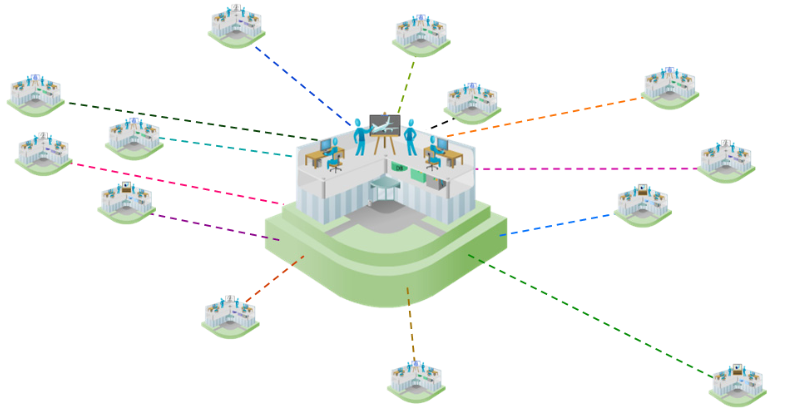In a recent article titled “Virtual vertical integration is the future of supply chain” SupplyChainManagement.com reported that Flextronics’ CPO and CSCO, Tom Linton, said that virtual vertical integration is:
“… managed alignment of external supply chain capabilities that leverages multiple levels of those capabilities to improve profitability and cash flow”, where the suppliers are seen as an extended enterprise that behaves as if internal to the company."
While Flextronics is referring to highly outsourced supply chains, the key message is just as applicable to multi-stage insourced supply chains, and to the planning process itself. The question is how do you get “an extended enterprise that behaves as if internal to the company”. It most certainly isn’t through overnight Electronic Data Interchange (EDI) messages flowing between ERP systems. Linton went on to state that:
“Transparency is difficult. It is one of the things we have to get over. We have to have it, because it defeats complexity and minimizes risk. … As complex as some of this sounds. It's about fundamentally looking at the multiple tiers of your supply chain and figuring out how to connect it in a way that gives you greater control and therefore your financials have greater results, whether it be cash, operating profit or revenue growth,” he concluded.
I don’t think complexity needs to be ‘defeated’, but if by ‘defeated’ Linton means ‘absorbed’ then I am in complete agreement. As Linton states, it isn’t just ‘transparency’, but ‘connectedness’ that is important. Undoubtedly transparency or visibility is a good place to start, but it is connectedness that makes a substantial difference to operating performance. Transparency only tells you the state of something, such as inventory, and whether or not it satisfies predefined targets. It is connectedness that tells you whether or not that something is of operational or financial importance. Let’s take two examples.
- The inventory targets of a key component have been set at 75-100, and the projected inventory is fluctuating around 80 for the next few periods. Sounds okay, right? Well, what if you are experiencing a demand spike for a finished good that normally only represents a demand of 5 per period for this key component, but now will represent 25 per period. Transparency isn’t going to tell you that you have a problem with raw material supply. Connectedness will.
- A supplier decommits on a delivery date by one week, which is well outside of the agreed service level conditions, but the supplier can expedite the shipment to meet expected delivery dates, at your expense. Transparency would say that you should expedite the shipment. Connectedness may tell you that you may be violating safety stock levels but that no demand will be impacted, so why expedite?
Some would say that they have ‘sufficient’ connectedness through daily MRP runs and overnight EDI messages. I don’t think this is good enough, and Gary Godfrey and Mark Pearson from Accenture don’t think so either. In a podcast entitled, “Why ‘dynamic’ is as crucial as ‘efficient’” they state that:
I was just talking about the fact of organizations in-ability to sense the market, capture the insight and then be able to disseminate and make decisions very rapidly so one of the core capabilities that we talk a lot about is this idea of insight to action, the ability to capture real time insight from the market and from sensing engines that you have. The ability to then be able to understand how do I want to respond to those changing market conditions and then be able to disseminate that into action across the organization.
It is well worth listening to the full podcast. Again, the emphasis is on translating the external signal across the entire organization, even the network, in as little time as possible. But, transmitting the signal through the network is only the first part of the ‘insight to action’ duo. Accenture then emphasizes the need for a cross-functional response, what they call ‘action across the organization’. This is what I call Concurrent Planning, which is the capability to plan and respond across the network, not in isolated functions. If you are trying to respond in a timely manner using a cascaded process supported by disparate functional applications you will fail. Accenture’s description also captures the idea of Plan + Monitor + Respond, which is the ability to put in place a plan, in reality an intent, to sense true demand and the current state of the supply network, and then be able to respond rapidly and profitably to true demand. These need to be three equal and complementary capabilities. The overall effectiveness of your supply chain will be determined by the weakest of these capabilities. Speed is quality.
What about Virtual Vertical Integration?
As long ago as 1998 Michael Dell, the founder of Dell computers, at the time the company leading the charge on both outsourcing of manufacturing and direct-to-customer distribution, in an interview in the Harvard Business Review titled, “The Power of Virtual Integration”, said that:
Virtual integration harnesses the economic benefits of two very different business models. It offers the advantages of a tightly coordinated supply chain that have traditionally come through vertical integration. At the same time, it benefits from the focus and specialization that drive virtual corporations. Virtual integration, as Michael Dell envisions it, has the potential to achieve both coordination and focus. If it delivers on that promise, it may well become a new organizational model for the information age.
What is clear is that Michael Dell was trying to regain the control over the supply chain Dell lost when they outsourced manufacturing. As Dell says, they were balancing the financial advantages of outsourcing with the operational benefits of vertical integration.
To achieve Dell’s vision requires a capability that goes well beyond visibility across tiers. There is too much decision latency embedded in a cascaded planning process that relies on daily MRP runs followed by overnight EDI transfers between MRP systems. This is what Linton was getting at with Virtual Vertical Integration, and what Accenture was getting at with the comparison of ‘dynamic’ and ‘efficient’. Speed is quality.
Additional Resources
- Supply chain control tower frequently asked questions






Discussions
Would you like to introduce the differences and relationships among CPFR, SCOR, integrated supply chain, Virtual Vertical Integration, supply chain control tower and so on that you think are relevant theories systematically?
Thanks a lot.
Best regards
Yuran
Leave a Reply